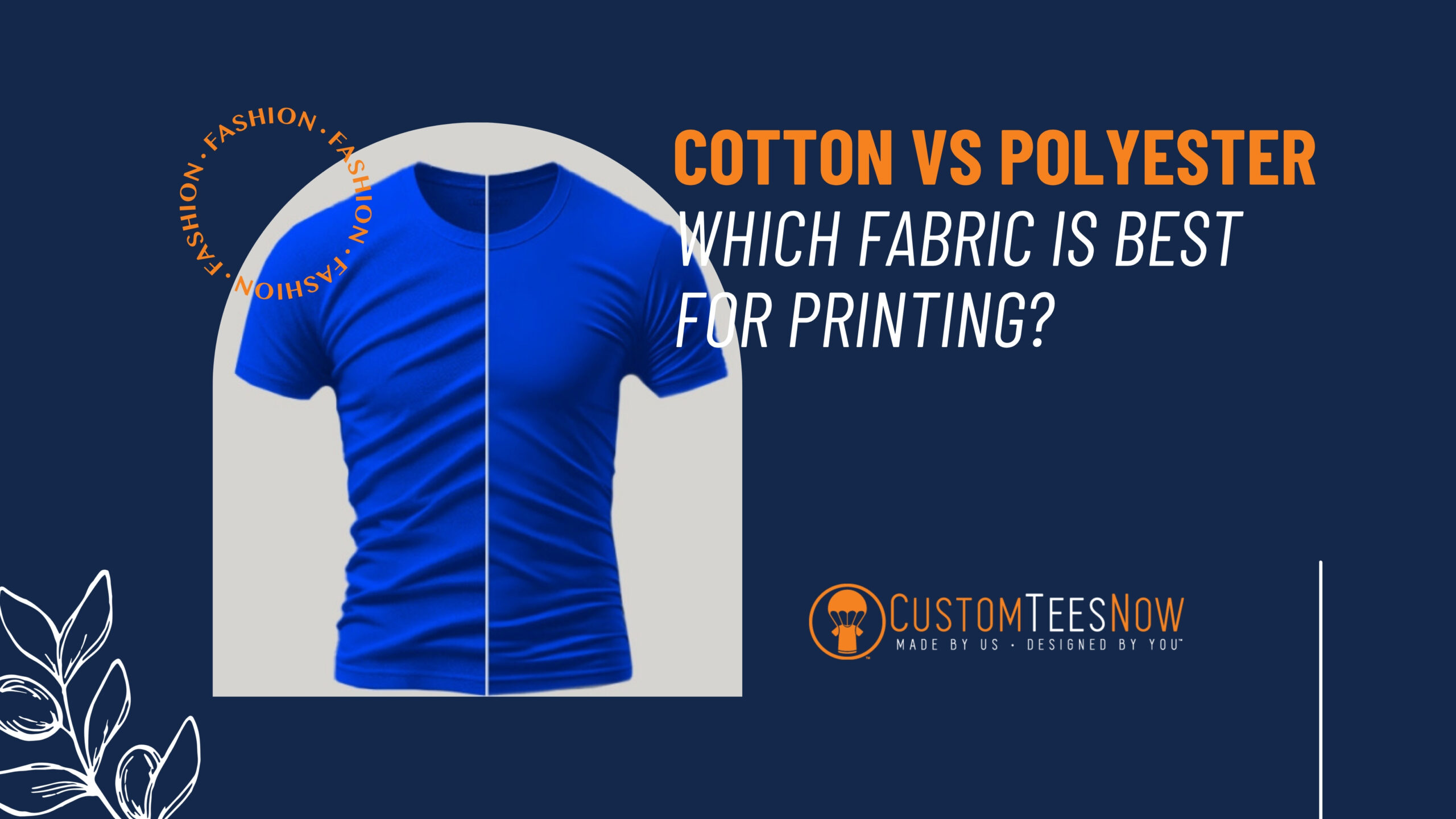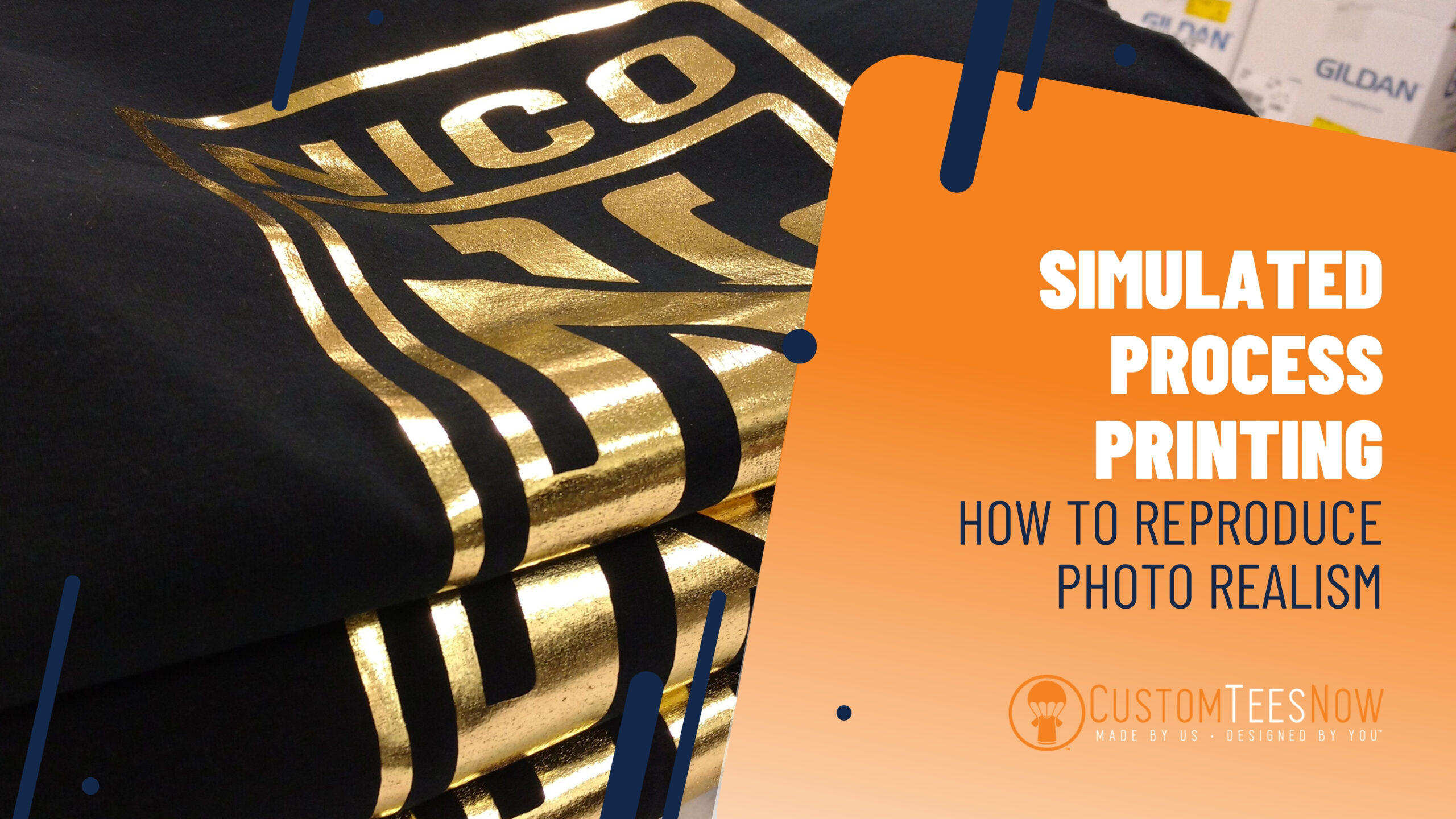
- October 30, 2025
Cotton vs Polyester: Which Fabric Is Best for Printing?
When designing custom apparel like t-shirts, hoodies, or promotional gear with custom printed t-shirts in Naples, FL, one of the first decisions you’ll face is choosing the right fabric. Cotton and polyester are the most popular options for printing, each offering unique benefits that affect everything from comfort and durability to print quality and cost. But which one is truly best for your custom printing project?
At CustomTeesNow, we’ve helped countless customers in Naples, FL, and beyond navigate this decision to create vibrant, long-lasting custom tees. In this comprehensive guide, we’ll break down the differences between cotton and polyester fabrics for printing, exploring their properties, printing compatibility, pros and cons, and real-world applications. Whether you’re outfitting a team with bulk printing, launching branded merch, or personalizing event swag using our online design tool, understanding these fabrics will help you select the ideal base for your upload design needs. Let’s dive in.
Understanding Cotton Fabric for Custom Printing
Cotton has long been the go-to fabric for custom t-shirts due to its natural origins and wearer-friendly qualities. Derived from the fluffy fibers of the cotton plant, this breathable material excels in everyday wear, making it a favorite for basic tees and casual garments.
Key Properties of Cotton
Cotton fabrics are prized for their softness and comfort. Here’s what makes them stand out:
- Breathability: Cotton allows air to circulate, keeping wearers cool and dry—ideal for warm climates or active use in custom performance tees.
- Absorbency: It soaks up moisture easily, which is great for sweat-wicking, but can affect ink adhesion during screen printing.
- Weight and Feel: Available in various weights (e.g., lightweight 4.5 oz for summer tees or heavier 6.1 oz for durability), cotton drapes naturally for a relaxed fit.
For custom printing, cotton’s texture provides a smooth canvas that enhances ink absorption, resulting in bold, vibrant colors in methods like screen printing.
Printing on Cotton: Techniques and Results
Screen printing thrives on cotton because its fibers hold inks tightly, preventing fading over time. Direct-to-garment (DTG) printing also works well, as cotton’s absorbency lets dyes penetrate deeply for photorealistic designs.
However, pre-treatment is often needed for optimal results, especially with water-based inks, to ensure even coverage. Cotton prints hold up through dozens of washes when cured properly, maintaining sharpness without cracking—perfect for no-minimum orders and single-shirt printing.
Understanding Polyester Fabric for Custom Printing
Polyester, a synthetic fabric made from petroleum-based polymers, revolutionized apparel with its engineered performance. It’s the backbone of athletic wear, uniforms, and custom performance tees, offering resilience in demanding environments.
Key Properties of Polyester
Polyester’s man-made composition gives it superior strength and versatility:
- Durability: Highly resistant to shrinking, wrinkling, and abrasion, making it perfect for repeated use in enterprise swag management.
- Moisture-Wicking: Hydrophobic fibers pull sweat away from the skin, promoting quick evaporation—essential for sports or outdoor activities.
- Lightweight and Stretch: Often blended with spandex for flexibility, polyester maintains its shape wash after wash.
When it comes to printing, polyester’s smooth, non-porous surface requires specialized techniques to avoid bleeding or dull colors, but it delivers exceptional longevity once applied correctly—ideal for custom hoodies and tote bags.
Printing on Polyester: Techniques and Results
Traditional water-based inks don’t bond well with polyester, so sublimation printing dominates here. This heat-transfer process infuses dye into the fabric, creating permanent, vibrant prints that won’t peel or fade—even after heavy wear. For other methods, such as screen printing, plastisol inks with additives ensure adhesion.
Polyester’s heat resistance allows for high-temperature curing, resulting in designs that withstand industrial laundering, which is why it’s common in workwear and custom embroidery services.
Pros and Cons: Cotton vs Polyester for Printing
Both fabrics have strengths, but their suitability depends on your project’s needs. Below is a comparison table highlighting key factors for custom printing.
| Print Quality | Excellent ink absorption for vivid, opaque prints | Best with sublimation for embedded, fade-proof colors |
| Durability | Good, but prone to shrinking and fading over time | Superior; resists wear, shrinking, and high-heat washing |
| Comfort | Soft, breathable; ideal for all-day wear | Moisture-wicking but can feel less breathable |
| Cost | Affordable custom tees; economical for bulk printing | Slightly higher upfront but longer lifespan reduces replacement costs |
| Best Printing Method | Screen printing, DTG | Sublimation, heat transfer |
| Eco-Friendliness | Natural and biodegradable | Synthetic; recyclable but petroleum-derived |
Advantages of Cotton for Printing
- Superior Color Vibrancy: Its porous nature allows inks to sink in, producing rich hues that pop on light or dark bases—great for designing your own t-shirt.
- Versatility: Works with most printing techniques without special equipment.
- Comfort Factor: Wearers love the natural feel, boosting satisfaction for casual custom apparel.
Drawbacks include potential shrinkage (up to 5% after washing) and less resistance to stains or heavy use.
Advantages of Polyester for Printing
- Longevity: Prints embedded via sublimation withstand extreme conditions, making them ideal for uniforms or promotional items, with fast free shipping.
- Performance Features: Quick-dry properties make it suitable for activewear where cotton might sag when wet.
- Consistency: Minimal shrinkage ensures designs stay aligned over time.
On the flip side, polyester can feel clammy in heat and requires precise printing to avoid a plasticky look.
Factors to Consider When Choosing Fabric for Your Custom Prints
Selecting between cotton and polyester isn’t a one-size-fits-all decision. Evaluate these elements to match fabric to your vision:
- End-Use and Audience: For casual events or everyday tees, cotton’s comfort wins. Athletic teams or corporate uniforms benefit from polyester’s toughness in custom performance tees.
- Design Complexity: Intricate, full-color graphics shine on cotton with DTG, while bold logos on polyester leverage sublimation’s all-over potential.
- Budget and Quantity: Cotton is cheaper for large runs via screen printing. Polyester’s specialized printing may add costs, but saves on reprints due to durability—check our price calculator for low prices.
- Climate and Care: In humid areas like Naples, FL, cotton breathes better; polyester excels in performance.
- Sustainability: Organic or recycled cotton appeals to eco-conscious buyers, while some polyester options incorporate recycled plastics.
Blends like 50/50 cotton/poly (e.g., 50/50) offer a hybrid: cotton’s softness with polyester’s durability, often printable with standard methods and available in brands we carry like Gildan and Port & Company.
Real-World Applications: When to Choose Each Fabric
Cotton in Action
Imagine a local charity run: Participants need breathable tees that feel great during miles of movement. Cotton screen printed with event logos provides that soft, absorbent base, ensuring the design stays vibrant through post-race celebrations.
For school spirit wear, cotton’s affordability supports bulk orders, letting budgets stretch to cover custom hoodies kids wear proudly.
Polyester in Action
Corporate retreats call for polyester polos sublimated with company motifs—the fabric’s wrinkle resistance keeps professionals sharp, and its moisture-wicking properties handle outdoor team-building.
Fitness brands thrive with polyester tanks: sweat evaporates quickly, and embedded prints retain brilliance after gym sessions.
At CustomTeesNow, we’ve seen polyester dominate for trade show swag, where items endure travel and frequent handling without losing appeal—delivered with free shipping guaranteed by Nov 12, 2025.
Maintenance Tips for Printed Cotton and Polyester Garments
To maximize your custom prints‘ lifespan:
- Washing: Turn garments inside out and use cold water. Avoid bleach on cotton to prevent color bleed; polyester handles warm cycles better.
- Drying: Air-dry cotton to minimize shrinkage; tumble-dry on low heat for polyester.
- Storage: Keep in cool, dry places away from direct sunlight to preserve prints.
Following these extended wear, whether it’s a cotton tee or a polyester jacket.
Cotton-Poly Blends: The Best of Both Worlds for Printing
Not ready to commit? Tri-blends (cotton, polyester, rayon) combine softness, stretch, and durability. They print well with DTG or screen printing, offering a vintage heather look that appeals to fashion-forward crowds. For example, a 52/48 cotton-poly blend balances breathability with shape retention, making it versatile for custom event merch.
Sustainability in Fabric Choices for Custom Printing
Eco-trends influence fabric decisions. Organic cotton reduces pesticide use, while recycled polyester diverts plastic waste. Both support vibrant printing without compromising ethics—choose GOTS-certified options for transparency.
Making the Right Choice for Your Custom Apparel Project
Ultimately, neither cotton nor polyester is universally “best” for printing; it hinges on your priorities. Cotton delivers unmatched comfort and easy printing for casual needs, while polyester ensures performance and endurance for active or professional use.
Ready to bring your designs to life? At CustomTeesNow, our experts guide you through fabric selection, from pure cotton tees to sublimation-ready polyester. Upload your artwork, get a free proof, and enjoy fast UPS shipping.
FAQs
Which fabric is better for custom t-shirt printing? Cotton is ideal for vibrant, soft-feeling prints with screen printing or DTG—perfect for casual wear. Polyester excels in durability and moisture-wicking, making it ideal for sublimation performance tees.
Does cotton or polyester shrink more? Cotton can shrink up to 5% if not pre-shrunk. Polyester resists shrinking and maintains shape after washing.
Can I print full-color designs on polyester? Yes—sublimation printing permanently embeds full-color, photorealistic designs into polyester, with no cracking or peeling.
Is cotton or polyester cheaper for bulk orders? Cotton is typically more affordable for large runs via screen printing. Polyester may cost more upfront but lasts longer, reducing the need for replacements.
Which fabric is best for hot climates like Naples, FL? Cotton breathes better and stays cooler. Polyester wicks sweat but can feel warmer in high humidity.
Are cotton-poly blends good for printing? Yes—50/50 cotton/poly blends offer softness, durability, and great printability with screen printing or DTG. Popular for heather-style tees.
How do I care for printed cotton vs polyester shirts? Wash cotton inside out in cold water, then air dry. Polyester handles warm water and low-heat drying. Avoid bleach on both.
Can I order just one custom t-shirt? Yes—no minimums at CustomTeesNow. Design online, get a free proof, and enjoy fast UPS shipping.


